
 |
| |
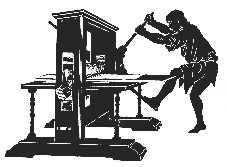
![]()
| A selection of interesting views | |||||||
|
|
||||||
|
| ||||||
| |||||||

In 1804 a Belgian-born priest, Charles Nerinckx (1761-1824), came to the United States. After studying briefly with the Jesuits at Georgetown, he was assigned to join seven other priests on the Kentucky frontier. Nerinckx was instrumental in establishing the Sisters of Loretto (formally, "Friends of Mary at the Foot of the Cross"), a teaching order of Catholic Sisters that was the first such religious congregation founded in the United States. In order to raise funds for a projected convent and school in Marion County, Nerinckx travelled back home in 1806/07 and engaged an artist named Courtois of Malines, Belgium, to create a view of the proposed little settlement. What emerged was a blend of the architectural and the fanciful. The buildings appear to correspond to the community as it eventually took shape, but the setting includes an alpine range in the background and palm trees scattered about! A key to the intended use of the buildings was appended in Flemish, French and English. A second version of this earliest view of a Kentucky settlement was published about 1816.
At the time of Nerinckx's final fund-raising visit home in 1818, a new plate was made for advertising purposes, and this print is from that plate. Courtois's name was removed and the explanatory text telling of the history of the mission, appealing for donations, and providing a key to the buildings is only in the Flemish version of Dutch. The key explains the aspects of the locale this way: a: convent and chapel, the only two-story building (note graveyard behind); b: the school; c: the kitchen and refectory; d: the courtyard; e: house of the sisters' servant; f: guesthouse and hospital; g: priest's house; h: house and kitchen of priest's cook; i: stables; k: main gates. In the center of the group of buildings the Sisters are depicted on their knees facing Mary, whose heart is being pierced with a sword and whose expansive cloak is being held by angels so that it protectively envelopes the Sisters. Mary stands at the foot of the cross bearing her bleeding son, while banners proclaiming "Jesus" and "Marie" float above the scene.
By 1824, Father Nerinckx had become exhausted from his work and his conflicts with both a younger priest, Father Chabrat, and with the bishop in Bardstown. He relocated to Missouri, dying that same year. Chabrat ordered the Sisters to relocate from their original settlement and destroyed his predecessor's books and papers. The Sisters obeyed, but burned down all the buildings save for the priest's house, to prevent the place being turned to a secular use. The Sisters continue to this day with the mission to "work for justice and act for peace because the Gospel urges us."
This wonderful view is a rare example of early Kentucky history and of frontier America of the period generally. $2,400
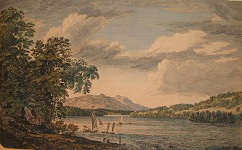
Paul Sandby after Thomas Pownall. [A View in Hudson's River of Pakepsey & the Catts-Kill Mountains, From Sopos Island in Hudson's River]. From Scenographia Americana. London, [1761-68]. 11 1/4 x 19 1/2 (sheet). Painted and engraved by Paul Sandby. Line engraving with hand color. Trimmed to image. Tape repairs on back. Cf. Deak: 106. Cresswell: 558.
Thomas Pownall, born in England in 1722, served in North America in various official positions between 1753 and 1760, including Governor of Massachusetts and South Carolina. During this time, Pownall traveled about the colonies, keeping a journal and making sketches of the sites he visited. Upon his return to England, Pownall hired Paul Sandby, the drawing master at the Royal Military Academy at Woolwich, England, to work with him on producing a set of engraved scenes based upon Pownall's sketches. This set was entitled Six Remarkable Views in the Provinces of New-York, New Jersey, and Pennsylvania in North America, and it was first published in 1761. In 1768 these prints were incorporated into Scenographia Americana, a portfolio containing twenty-eight prints by Pownall and other artists. The engraving of the prints in these series is superb, with texture, lighting, and motion all conveyed with remarkable vividness. This print was issued in this series and shows the area near Poughkeepsie looking from Esopus Island which is half way between Hyde Park and Staatsburg today. The landscape is archetypical of the potential bounty of the continent which the British had fought for in the just ended French and Indian Wars and which they were soon to lose in the Revolution. Pownall was a strong supporter of the argument that the American colonies were of such potential that the British should do everything possible to keep them within the British empire. This is an excellent example of Pownall's point, a strong symbol of wealth and potential in the "New World." $600
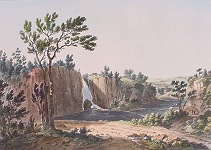
Joshua Shaw. "Passaic Falls, New Jersey." From Picturesque Views of American Scenery. Philadelphia: M. Carey & Son, 1819-21. 10 x 13 7/8. Aquatint with line etching by John Hill. Original hand color. Full margins. Hand colored. Very good condition.
A rare print from a very interesting series of American views that combine the work of some of the most talented Americans of the early nineteenth century. Joshua Shaw (ca. 1777-1860) was born and trained in England, and he became so enthralled by his new country that he conceived the grand scheme of producing a folio of prints based on "correct delineations of some of the most prominent beauties of notable scenery." He planned to travel throughout the United States to make his drawings, and to issue the prints by subscription in six sets of six views each. This was the first systematic attempt to depict the American landscape, and it is a foundation work in the history of American color-plates. Only eighteen of the intended thirty-six prints were produced, for either Shaw ran out of energy, or the public did not sufficiently support the venture. The aquatinting of the prints was done by John Hill (1770-1850), who was another Englishman who had just settled in Philadelphia. This was Hill's first major American commission, and the next year he moved to New York City where he further enhanced his reputation as the premier aquatinter in the country. The publisher of the series, Mathew Carey & Son, was no less illustrious than the others. Mathew Carey was perhaps the dominate American publisher of the first two decades of the nineteenth century, and the successor firms of Carey & Son, and then Carey & Lea continued to play an important part in the history of American maps, books and prints. The prints from this series are rare and lovely. They are beautifully rendered, exquisitely aquatinted and finely colored. $1,800
![]() Go to page with other views from the Shaw-Hill series
Go to page with other views from the Shaw-Hill series
Views from The Analectic Magazine. Philadelphia: 1817-1820. Engravings. Very good condition unless noted otherwise.
In 1812, Philadelphia bookseller and publisher Moses Thomas purchased a monthly magazine entitled Select Reviews, engaged Washington Irving as editor, and renamed the publication The Analectic Magazine. Irving, his brother-in-law J. K. Paulding, Gulian C. Verplanck and, later, Thomas Isaac Wharton wrote much of the material, which concentrated on literary reviews, articles on travel and science, biographies of naval heroes, and reprints of selections from British periodicals. Illustration "was one of the magazine's chief distinctions. Not only were there the usual engravings on copper, but some of the earliest magazine experiments in lithography and wood engraving appeared here. The plates were chiefly portraits, though some other subjects were used." (Mott, A History of American Magazines)
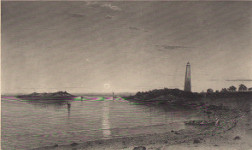
James Augustus Suydam (1819-1865) was an American landscape painter, architect and lawyer. As a painter, he was considered one of the leaders of the Hudson River School of painting, and a premier Luminism practitioner. A native of New York City, a graduate of New York University, and a descendant of an old New York Dutch merchant family, Suydam was know for peaceful landscapes illustrating the play of light on water. Suydam's painting, made in 1863, shows a charming view of the Sound just after sunrise with a lone boatman casting off from the beach in the foreground. $175
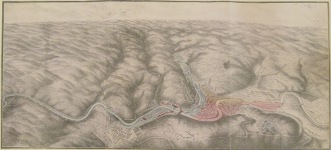
JOHNSTOWN, PA. "Bird's Eye View of the Conemaugh Valley." Circa post May 31, 1889. 11 3/4 x 26 1/2 (neatlines) plus full margins. Lithograph with some hand color. A cryptic note at bottom right states "Copyright applied for." Brittle with folds as issued. Not in Reps. A scarce piece.
A fine example of the American bird's eye view of the nineteenth century. Beginning after the Civil War, the bird's eye view became one of the most popular of print genres. This was a period of significant urban growth throughout the country, and the civic pride which proliferated provided a fertile field for print publishers to market these visual vistas of American cities and towns. According to John Rep's seminal Views and Viewmakers of Urban America (Columbia, 1984), publishers sent their artists out into the field throughout all parts of the country to draw and market the views. The artist would walk the streets of the town or city, drawing all the buildings and encouraging the citizens to subscribe to the view that would be produced. Once the entire area was sketched and enough subscriptions obtained, the artist would use a standard projection to turn his street-level images into a bird's eye view of the town. Because these views were primarily sold to citizens of the place depicted, they had to be accurate and all buildings shown. Thus these views are not only highly decorative, but are also detailed and accurate pictures of each place shown, providing us with a wonderful documentation of nineteenth century urban America.
This is an especially interesting view because its creation was generated out of the Johnstown Flood disaster. The subtitle explains that the picture shows "the different currents by colors." Red oblongs represent houses that were left after the flood. Topography and roads illustrate the surrounding region that located the sources of the waters and the track of the destruction. Numbers on the elevated view are keyed to forty places listed below the image in the bottom margin. $425
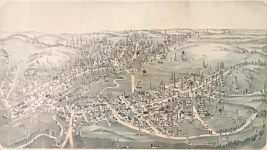
T.M. Fowler. "Scio, Ohio, 1899." Morrisville, Pa.: T.M. Fowler & J.B. Moyer, 1899. 13 1/8 x 23 3/4 (image). Top margin corners missing, expertly conserved and lined with mulberry paper. A few minor surface blemishes in margins. Overall, very good condition.
A fine example of the American bird's eye view of the nineteenth century. Beginning after the Civil War, the bird's eye view became one of the most popular of print genre. This was a period of significant urban growth throughout the country, and the civic pride which proliferated provided a fertile field for print publishers to market these visual vistas of American cities and towns. According to John Reps' seminal Views and Viewmakers of Urban America (Columbia, 1984), publishers sent their artists out into the field throughout all parts of the country to draw and market the views. $700
![]()
For further information, please contact:

![]()
106 E. Lancaster Avenue, Lower Level
Wayne, PA 19087 USA
610.808.6165
PhilaPrint@PhilaPrintShop.com ![]()
©The Philadelphia Print Shop Last updated July 20, 2021